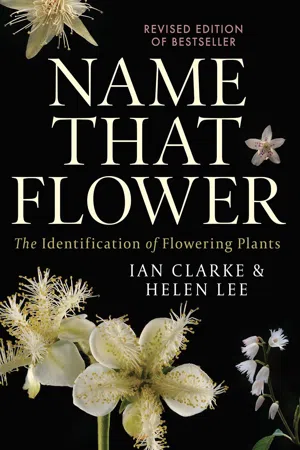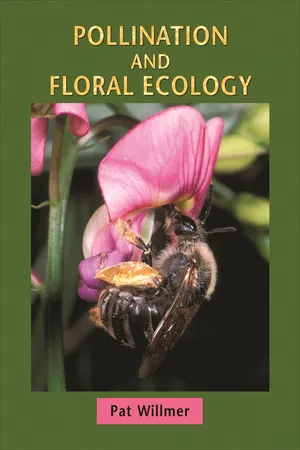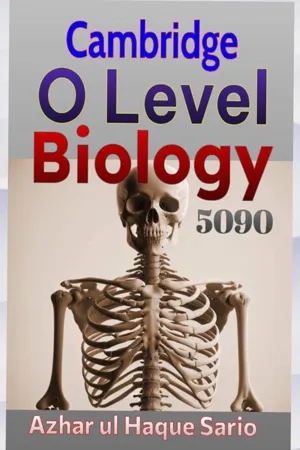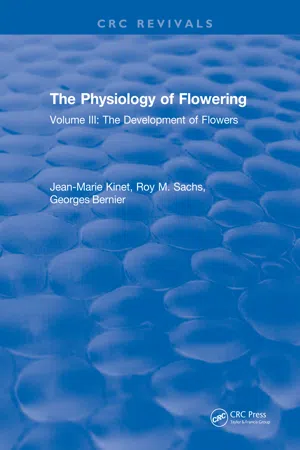Biological Sciences
Flower Structure
The flower structure refers to the arrangement of the essential reproductive parts of a flower, including the male stamen and the female pistil, as well as the surrounding petals and sepals. These structures play a crucial role in the process of pollination and fertilization, ultimately leading to the production of seeds and the continuation of plant species.
Written by Perlego with AI-assistance
Related key terms
7 Key excerpts on "Flower Structure"
- Ian Clarke, Helen Lee(Authors)
- 2019(Publication Date)
- Melbourne University Press Digital(Publisher)
2 The Structure of FlowersThere are many ways in which the various flower parts can be arranged to make up the structure we recognise as a ‘flower’. This chapter sets out to describe the structure of a simple flower, and then discusses some of the variation commonly encountered. Chapter 8 includes some more complex examples.Floral structure is described under the following headings: Structure of a basic flower The perianth The reproductive organs Variation in floral structure Arrangement and union of parts The perianth The calyx The corolla Symmetry Aestivation The reproductive organs The androecium The gynoecium Placentation The style and stigma Discs and nectaries Relationships of parts in the flower The floral tube Number of parts per whorl Unisexual flowers The floral formulaStructure of a basic flowerA basic flower (Fig. 1 ; Pl. 1) has four series of parts arranged in concentric whorls (or rings) on the receptacle, which is the name given to the expanded end of the pedicel (flower stalk). The two outer whorls are together known as the perianth, and are not directly involved in reproduction. The reproductive structures are located in the inner whorls.The perianthThe outer whorl, known as the calyx, is composed of two or more parts called sepals, which are often green in colour and enclose the rest of the flower in the bud stage. Inside the calyx is the corolla, made up of petals, which are usually white or brightly coloured. It is usual for the sepals and petals to be equal in number.The reproductive organsA whorl of stamens, called the androecium, lies inside the corolla, and is generally taken to represent the male part of the flower. Each stamen has a slender filament (stalk) and, at the top, an anther in which the pollen is produced. The pollen grains carry the male reproductive units.In the centre of the flower is the gynoecium, made up of carpels. Each carpel usually has three parts: an expanded basal part called the ovary, in which the ovules are produced; a central stalk-like section called the style; and a terminal stigma- eBook - ePub
- Andrew Lack, David Evans(Authors)
- 2021(Publication Date)
- Taylor & Francis(Publisher)
Section G - Reproductive biologyG1 THE FLOWERKey Notes
General structure of the flower
In a typical flowering shoot there is a receptacle at the top of a stem with four whorls of floral organs: sepals, petals, stamens and carpels. In some plants one or more whorls may be absent, e.g. in unisexual flowers and reduced flowers of wind-pollinated plants.Sepal and petal structure
Sepals are usually green and protective, resembling simple leaves. Petals are often brightly colored and attractive to animals with a specialized epidermis, often pigmented vacuoles and air-filled reflective mesophyll. The pigments are mainly flavonoids with some betalains and carotenoids. Insects have different color sensitivity from us and the colors of petals are different and more varied for insects.Stamens
The stamens have a filament with four or two anthers. The anther wall has three layers and splits (dehisces) to release pollen. Some plants have specialized dehiscence such as only releasing pollen when insects vibrate their wings and orchids have sticky pollen masses known as pollinia. The filaments may be long and thin or flat and some are sensitive to insect contact.Carpels
The carpel consists of an ovary enclosing the ovules, usually a stalk, the style, and a stigma with a receptive surface for pollen grains. The ovaries may be separate or fused, and on the surface, i.e. superior, or buried in the receptacle, inferior. In animal-pollinated plants the stigma is club-shaped or lobed and may be dry or sticky; in wind-pollinated plants it usually feathery with a large surface area. The ovaries contain one to many ovules. The ovules usually have two integuments and a nucellus surrounding the embryo sac, with a tiny gap, the micropyle, for pollen tube entry.Nectar
Nectar is mainly a sugar solution of varying concentration with small quantities of other substances. It is secreted at the base of the petals or elsewhere in the flower. Many flowers have no nectar and use pollen as a food reward, more rarely oil or resin. - eBook - ePub
- Patricia Willmer(Author)
- 2011(Publication Date)
- Princeton University Press(Publisher)
1. Essential Flower Morphology
Flowers are complicated assemblages of plant parts, modified originally from leaves. Repetitive patterns of units occur in series, growing centripetally and sitting upon the flower stalk. Table 2.1 shows the general patterns of floral parts, with the four main series of structures from base to tip, or outer to inner: sepals , petals , stamens , carpels . This fundamental structure can be detected in most flowers from the basic arrangement in figure 2.1 A, though the details vary enormously; these details can often be conveniently expressed in terms of a simple flower diagram of the type shown in figure 2.1 B. In particular, the numbers of each part are highly varied: primitive magnoliids have very large numbers of petals, as do cacti, but in many dicot plants there are just five petals and five sepals, whereas in most monocots these structures come in threes. Even here many exceptions occur, and some important groups, such as the crucifers (Brassicaceae) and the poppies (Papaveraceae), have their parts in multiples of two or four. These petal and sepal numbers may or may not be reflected in the inner series of stamens and carpels: in the geranium family all the parts are in fives, and in the lily and iris families all are in threes, but in some other families this numerical consistency is lost, often with fewer carpels and more stamens than there are petals and sepals.During flower development each part or series forms in sequence, and is in turn influenced by the initiation and growth of neighboring structures. The original apical meristem that will form the flower is protected in a bract , within which floral organs are initiated; then as floral morphogenesis progresses, the first series of structures, the sepals, grows and surrounds the bud , within which the petals and the androecium (male) and gynoecium (female) form sequentially. To add further variety, the fundamental structures may fuse into a ring as they arise or during ontogeny to form tubular organs. And sometimes parts of different floral organs may fuse, to form organ complexes. However, the basic underlying anatomy can still usually be described by a simple floral diagram as in figure 2.1 - eBook - ePub
- Azhar ul Haque Sario, Azhar ul Haque Sario(Authors)
- 2023(Publication Date)
- tredition(Publisher)
Wind-pollinated flowers generally have a reduced or absent corolla (petals) since attracting pollinators is not necessary. Their focus is on efficiently releasing and capturing pollen through the wind, which is reflected in the prominent and specialized structures of their anthers and stigmas.Flowers, the reproductive structures of flowering plants, are marvels of nature's design. Each part of a flower plays a crucial role in the plant's reproductive process, particularly in insect-pollinated flowers. Let's explore the structure and function of these key parts: sepals, petals, stamens (which include anthers and filaments), and carpels (consisting of stigmas, styles, ovaries, and ovules).SepalsThe sepals are like the protective guardians of the flower. They form the outermost part of the flower, appearing as green, leaf-like structures. These are the flower's first line of defense, safeguarding the delicate inner parts when the flower is in bud form. Sepals act like a safety cover, shielding the developing petals and reproductive parts from harsh weather, hungry insects, and other potential dangers. Their structure is sturdy yet flexible, perfectly designed for protection.PetalsPetals are the show-stoppers of the flower world. They are often brightly colored, soft, and delicate, designed to catch the eye—or more accurately, the attention—of insects. In insect-pollinated flowers, petals serve as vibrant billboards, advertising the flower's nectar and pollen to passing bees, butterflies, and other pollinators. The diverse colors, patterns, and even scents of petals are all tailored to attract specific types of insects. Once attracted, these insects inadvertently assist in the plant's reproductive process by transferring pollen from one flower to another.Stamens: Anthers and FilamentsEach stamen has two main components: the anther and the filament. The filament is a slender stalk that elevates the anther, positioning it strategically so that visiting insects brush against it. The anther, located at the top of the filament, is the pollen-producing part of the flower. It's like a tiny pollen factory, where the plant's male reproductive cells are produced and stored. When insects visit the flower, they brush against the anthers and pick up the pollen, which they then transport to other flowers, aiding in fertilization. - eBook - ePub
The Physiology of Flowering
Volume III: The Development of Flowers
- Jean-Marie Kinet(Author)
- 2018(Publication Date)
- CRC Press(Publisher)
Section V on cellular and molecular changes observed during flower development terminates this chapter.Some of the terms, e.g., carpel, we shall use in our descriptions are unfortunately not simply descriptive but interpretive since they have been created or used by morphologists within the framework of conflicting theories on the interpretation of the nature of inflorescences and flowers. There is little need and no gain to the physiologist in entering these controversies. The unavoidable use of morphological terms in this volume is purely descriptive and does not imply acceptance of the corresponding theories.II. Some Case Descriptions
A. Solitary Flowers
Tulip (Tulipa gesneriana ) plants produce a solitary flower at the top of their main axis. The apical meristem, from which next year’s flower will develop, produces three to five foliage leaves, then increases in size and height and initiates in rapid sequence: (1) the three outer perianth members or tepals (Figure 1A ), (2) the three inner tepals, (3) the outer whorl of three stamens, each located in the axil of an outer tepal (Figure 1B ), (4) the inner whorl of three stamens, each located in the axil of an inner tepal, and (5) the three carpels which alternate with the three inner stamens (Figure 1C ). Several workers claimed that each tepal and associated stamen, in other Liliaceae species related to the tulip, arise together from a unique primordium and become distinct only during later growth.1 , 3 , 4 Work by Shoub and de Hertogh with the more refined technique of scanning electron microscopy (SEM) has shown, however, that tepals and stamens are initiated independently (Figure 1 ), even though they may have the appearance of a united primordium with a dissecting light microscope.5 The meristem, which is dome shaped until stamen initiation, becomes flat topped later on. Carpels appear as three crescent-like ridges which are initially free. The carpellary ridges grow towards the center of the flower where their margins meet and fuse. The compound ovary then grows upward and produces a three-lobed stigma at its top (Figure 1D - eBook - ePub
- Donald Kaplan, Chelsea D. Specht(Authors)
- 2022(Publication Date)
- CRC Press(Publisher)
Morphology of Reproductive Shoots III. The Angiosperms B. The Floral Organs in Their Pre- and Post-Fertilization States CONTENTS- Comparative Morphology of the Major Floral Whorls
- The Perianth (Perigon)
- The Calyx
- The Corolla
- The Androecium: Basic Morphology of the Microsporophyll
- Modes of Anther Dehiscence
- Reductions of Thecae and Sporangia
- Divergence and Dislocation of Thecae and Transverse Anthers
- Comparative Development of the Filament Region of Stamens
- The Gynoecium
- The Classical Model of a Carpel
- Carpels as Peltate/Tubular Appendages
- Modes of Placentation in Apocarpous Gynoecia
- The Perianth (Perigon)
- Synorganization in Floral Structure
- The Concept of Floral Organ Fusion
- Postgenital Organ Fusion
- The Histology of Postgenital Fusion
- Congenital Fusion
- Changes in the Morphology of the Floral Organ Whorls as a Result of Synorganization
- The Synsepalous Calyx
- The Sympetalous Corolla
- Synandrous Androecium
- Postgenital Fusion of Stamens
- Congenital Fusion of Stamens
- Syncarpous Gynoecium
- Patterns of Placentation in Syncarpous Gynoecia
- The Functional Significance of Syncarpy
- The Path of Pollen Tube Growth in the Gynoecium
- Ovule Structure in Relation to the Path of Pollen Growth in the Gynoecium
- The Genesis of Spores and Gametes
- Microsporogenesis and Microgametogenesis
- Megasporogenesis and Megagametogenesis
- Ovule Initiation in Relation to the Development of the Flower
- Ovule Development: Megasporogenesis and Megagametogenesis
- Structure and Function of the Mature Megagametophyte
- Variations in the Patterns of Megagametogenesis in Angiosperms and Their Developmental and Genetic Significance
- Monosporic Types
- Bisporic Types
- Tetrasporic Types
- General Conclusions on the Development of the Megagametophyte as Deduced from the Comparative Development of the Megagametophyte of the Angiosperms
- Changes in Floral Morphology in the Post-Fertilization State (Floral vs. Fruit Development)
- eBook - ePub
- Patricia Barnes-Svarney, Thomas E. Svarney(Authors)
- 2014(Publication Date)
- Visible Ink Press(Publisher)
Sepals —The sepals are found on the outside of the bud or on the underside of the open flower. They serve to protect the flower bud from drying out. Some sepals ward off predators by displaying spines or secreting chemicals. Collectively, the sepals form the calyx.Petals —The petals attract pollinators and are usually dropped shortly after pollination occurs. Collectively, the petals form a corolla.Stamen —The stamen is the male part of a flower. It consists of a filament and anther, where pollen is produced.Pistil —The pistil is the female part of a flower. It consists of the stigma, style, pollination tube, and ovary, which contains ovules. After fertilization, the ovules mature into seeds.The parts of a flower. Many flowers can be identified based upon the number of their parts.How are many flowers are easily identified based on their parts?
Many flowers can often be identified by their parts—in particular, the number of sepals, petals, and stamens. For example, a stonecrop succulent plant has thirty sepals, thirty petals, and thirty or sixty stamens; buckwheat has three to six sepals, no petals, and six or nine stamens. But it’s not really that cut and dried—for example, a jewelweed has three or five unequal sepals, one forming a spur, and five petals, two united and three separate. And with so many species of plants—including trees identified by their seeds— it’s no wonder identifying plants is truly a major study!What are the types of plant pollination?
Effective pollination occurs when viable pollen is transferred to a plant’s stigmas, ovule-bearing organs, or ovules (seed precursors). Without pollination, no fertilization would occur. Since plants are immobile organisms, they usually need external agents to transport their pollen from where it is produced in the plant to where fertilization can occur. This situation produces cross-pollination, wherein one plant’s pollen is moved by an agent to another plant’s stigma. Some plants are able to self-pollinate—transfer their own pollen to their own stigmas. But of the two methods, cross-pollination seems more advantageous, for it allows new genetic material to be introduced.
Index pages curate the most relevant extracts from our library of academic textbooks. They’ve been created using an in-house natural language model (NLM), each adding context and meaning to key research topics.






